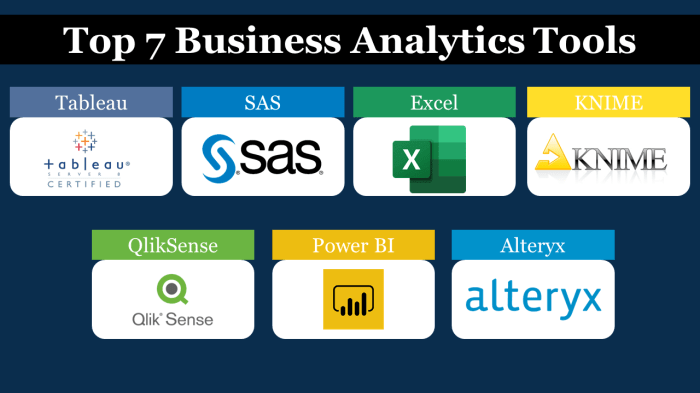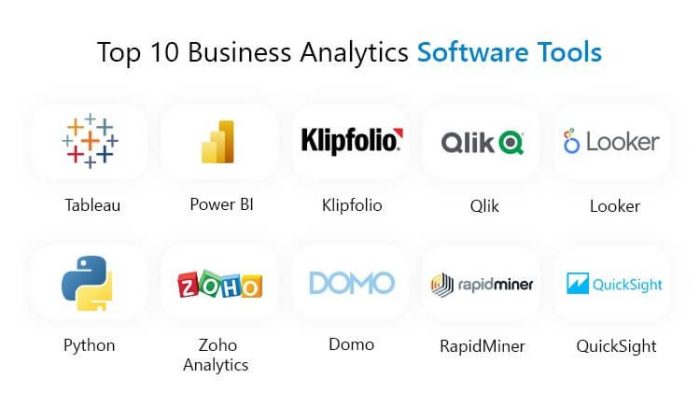Business analytics tools are the game-changers in today’s data-driven world, empowering businesses to harness insights for strategic decision-making. Dive into the realm of analytics tools and discover their transformative impact.
Ready to explore the dynamic landscape of business analytics tools that are reshaping the business realm? Let’s delve into the details of these powerful tools and how they revolutionize decision-making processes.
Overview of Business Analytics Tools

Business analytics tools are software applications that are used to collect, process, analyze, and visualize data to help organizations make informed decisions. These tools play a crucial role in modern businesses by providing valuable insights and actionable information based on data-driven analysis.
Importance of Using Business Analytics Tools
- Enhanced decision-making: Business analytics tools allow companies to make decisions based on real data and insights rather than relying on gut feelings or intuition.
- Improved operational efficiency: By analyzing data, businesses can identify areas of inefficiency and optimize processes to increase productivity.
- Competitive advantage: Utilizing analytics tools can help businesses stay ahead of the competition by identifying trends, patterns, and opportunities in the market.
- Increased profitability: Making data-driven decisions can lead to cost savings, revenue growth, and overall improved financial performance.
How Business Analytics Tools Help in Making Data-Driven Decisions
- Data collection: Business analytics tools gather data from various sources, such as internal databases, external sources, and real-time feeds.
- Data processing: The tools clean, transform, and organize the data to make it suitable for analysis, ensuring data accuracy and consistency.
- Data analysis: Using advanced algorithms and statistical models, these tools analyze the data to uncover insights, trends, and correlations.
- Data visualization: Business analytics tools present the analyzed data in visual formats such as charts, graphs, and dashboards to make it easier for users to understand and interpret.
Types of Business Analytics Tools
Business analytics tools come in various types, each serving a unique purpose in analyzing and interpreting data to drive informed business decisions.
Predictive Analytics Tools
Predictive analytics tools utilize historical data and statistical algorithms to forecast future trends and outcomes in business operations. These tools help businesses anticipate customer behavior, market trends, and potential risks.
Data Visualization Tools
Data visualization tools enable businesses to represent complex data sets in visually appealing graphics such as charts, graphs, and dashboards. These tools make it easier for users to interpret data and identify patterns or trends at a glance.
Descriptive Analytics Tools
Descriptive analytics tools focus on summarizing historical data to provide insights into past performance and trends. These tools help businesses understand what has happened in the past and why, serving as a foundation for more advanced analytics.
Prescriptive Analytics Tools, Business analytics tools
Prescriptive analytics tools go beyond predicting outcomes to recommend actions that can optimize decision-making processes. These tools use advanced algorithms and machine learning to suggest the best course of action based on data analysis.
Popular Business Analytics Tools in the Market

When it comes to business analytics, having the right tools can make all the difference in unlocking valuable insights and making informed decisions. Let’s take a look at some of the top business analytics tools that are widely used in the market today.
Tableau
Tableau is a powerful data visualization tool that allows users to create interactive and shareable dashboards. Key features include drag-and-drop functionality, real-time data analytics, and a wide range of visualization options. Pros of using Tableau include its user-friendly interface and the ability to quickly create visually appealing reports. However, some cons include the high cost of licensing and limited customization options.
Power BI
Power BI is a business analytics tool by Microsoft that enables users to visualize and share insights from their data. Key features of Power BI include data modeling capabilities, AI-powered analytics, and seamless integration with other Microsoft products. Pros of using Power BI include its robust data connectivity and collaboration features. On the other hand, some cons include a steeper learning curve for beginners and limited customization options compared to other tools.
Google Analytics
Google Analytics is a web analytics tool that provides valuable insights into website traffic and user behavior. Key features of Google Analytics include audience segmentation, goal tracking, and e-commerce tracking. Pros of using Google Analytics include its free version for small businesses and the ability to track a wide range of metrics. However, some cons include the complexity of the platform for beginners and the need for customization to get more advanced insights.
Implementation of Business Analytics Tools
Implementing business analytics tools within an organization can greatly enhance decision-making processes and overall efficiency. It is crucial to follow best practices to ensure a successful integration.
Best Practices for Implementing Business Analytics Tools
- Define clear objectives and goals for implementing the tools.
- Ensure top-level management support and involvement throughout the process.
- Provide adequate training to employees to maximize the use of the tools.
- Start with a pilot project to test the tools before full-scale implementation.
- Regularly monitor and evaluate the performance of the tools to make necessary adjustments.
Challenges in Implementing Business Analytics Tools
- Resistance to change from employees accustomed to traditional methods.
- Data integration issues when combining data from different sources.
- Ensuring data security and compliance with regulations.
- Choosing the right tools that align with the organization’s specific needs and goals.
Successful Integration of Business Analytics Tools in Real-world Business Scenarios
One example of successful integration of business analytics tools is a retail company using predictive analytics to forecast customer demand and optimize inventory levels. By analyzing historical sales data and external factors like weather patterns, the company was able to reduce stockouts and overstock situations, leading to increased profitability and customer satisfaction.